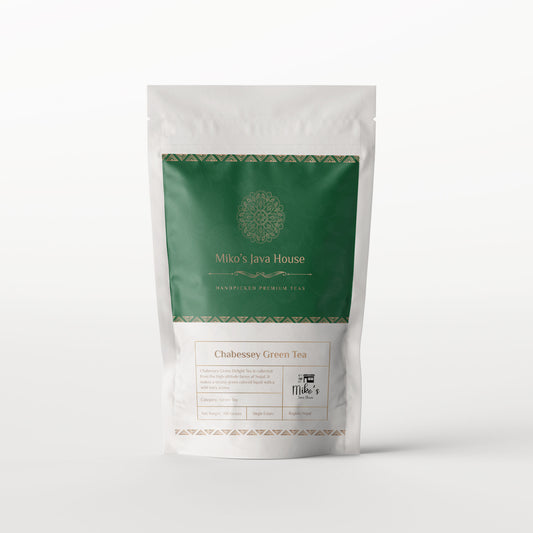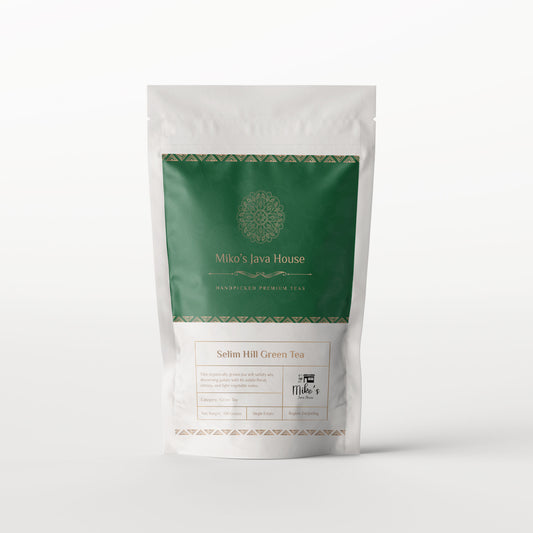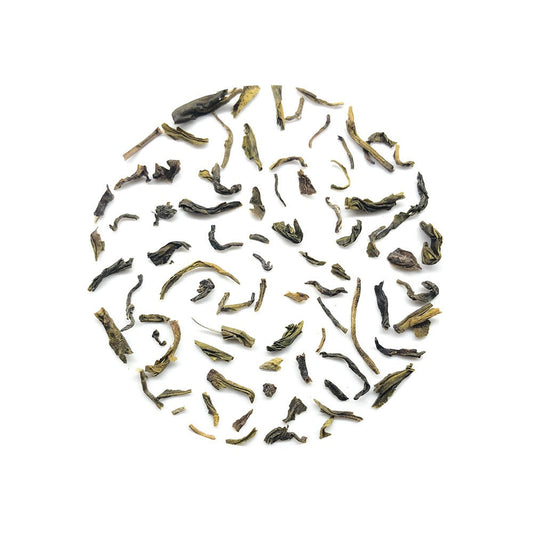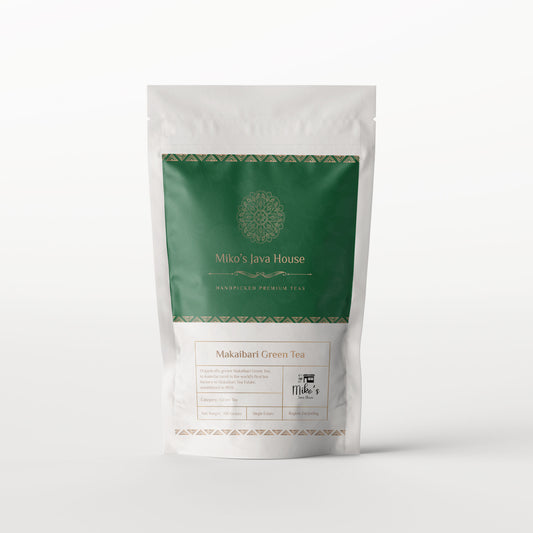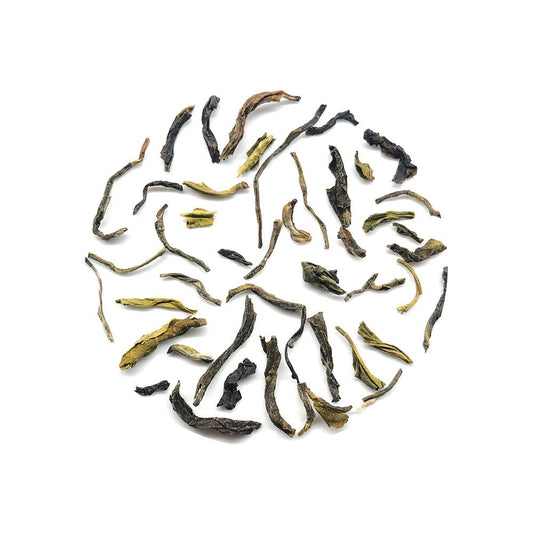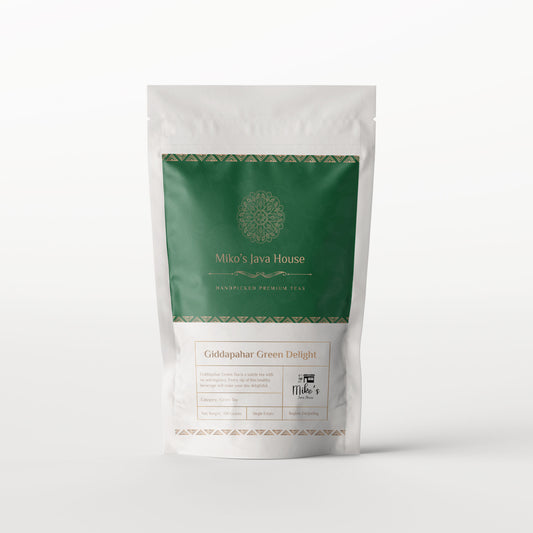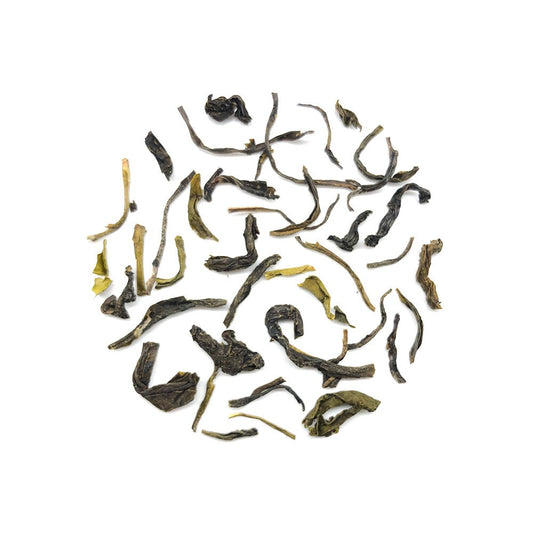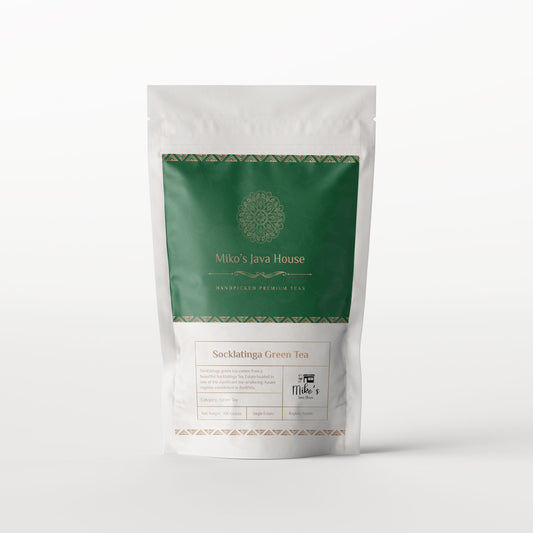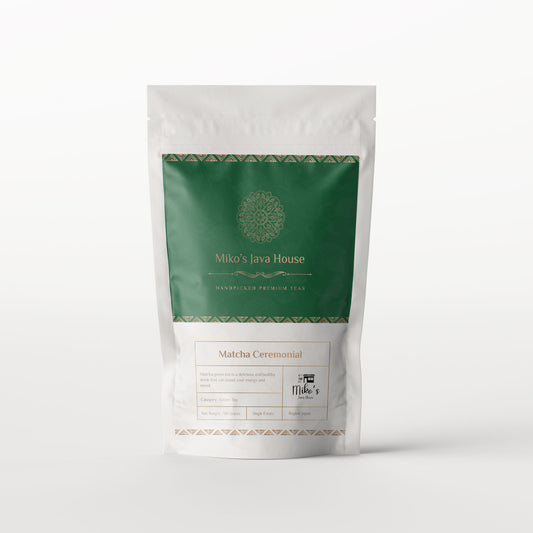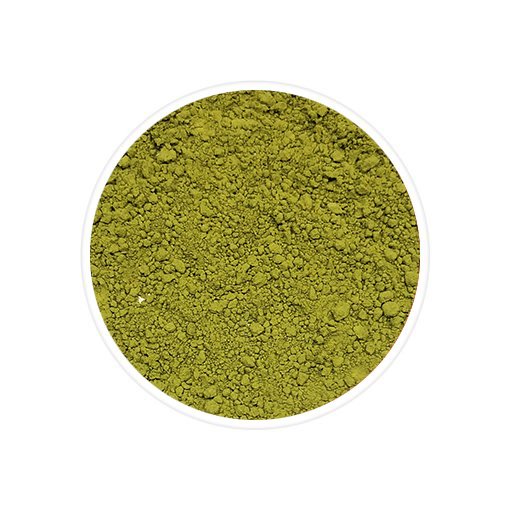Green Teas
Sourced from the finest tea gardens, our curated selection offers a symphony of flavors and wellness benefits. Explore our Green Tea Collection today for a journey to well-being, one cup at a time.
-
Chabessey Green Tea
Regular price $16.87USDRegular priceUnit price / per -
Selim Hill Green Tea
Regular price $18.15USDRegular priceUnit price / per -
Makaibari Green Tea
Regular price $17.95USDRegular priceUnit price / per -
Giddapahar Green Tea
Regular price $17.25USDRegular priceUnit price / per -
Socklatinga Green Tea
Regular price $17.47USDRegular priceUnit price / per -
Matcha Ceremonial
Regular price $22.43USDRegular priceUnit price / per
Collapsible content
About Green Teas
Unveiling the Magic of Green Tea: Your Gateway to Wellness
Green tea, a name synonymous with tranquility and health, is more than just a delicious beverage. It's a journey into a world of subtle flavors and a treasure trove of potential health benefits. But what exactly is green tea, and why should it be a part of your life?
Green Tea: A Celebration of Freshness
Green tea, unlike its black tea counterpart, undergoes minimal processing. The leaves of the Camellia sinensis plant are either steamed or pan-fired shortly after harvesting, preserving their vibrant green color and delicate flavor profile. This minimal processing allows green tea to retain a higher concentration of antioxidants – those powerful natural compounds that may help protect your cells from damage.
A Cup Full of Goodness
Green tea has been revered for centuries in Eastern cultures for its potential health benefits. Modern research suggests these benefits might include:
- A Treasure Trove of Antioxidants: Green tea boasts a rich content of antioxidants known as catechins, which may help combat free radicals in the body and contribute to overall well-being.
- Boosting Cognitive Function: Studies suggest green tea may improve focus, memory, and alertness, thanks in part to the presence of caffeine and L-theanine, an amino acid known for its calming effects.
- Supporting Weight Management: Green tea may play a role in weight management by potentially boosting metabolism and promoting healthy fat burning.
Who Should Embrace Green Tea?
Green tea's appeal is wide-ranging. Here's why you might love it:
- Health-Conscious Individuals: Looking for a natural way to support your well-being? Green tea's potential health benefits might be just what you're looking for.
- Tea Enthusiasts Seeking Variety: The world of green tea offers a spectrum of flavors, from grassy notes to hints of seaweed. Explore and discover your perfect cup!
- Lovers of Lighter Flavors: If you prefer a more subtle taste compared to bold black tea, green tea's delicate profile might be your ideal match.
Whether you're a seasoned tea drinker or a curious newcomer, green tea has something to offer. So, delve into the world of green tea, explore its diverse flavors, and experience the potential health benefits this cup of goodness has to offer!
Unveiling a World of Green: Exploring Green Tea Varieties
Green tea, with its vibrant emerald hues and refreshing taste, is a global beverage enjoyed for centuries. But did you know this seemingly simple tea offers a surprising range of flavors and characteristics? Let's delve into the fascinating world of green tea varieties and discover how processing methods influence their unique taste profiles!
A Spectrum of Green:
Green tea isn't just one type of tea; it's a diverse family united by one key factor: minimal oxidation. Unlike black tea, green tea leaves are left largely unoxidized, preserving their natural green color and delicate flavors. However, within this category, variations in processing techniques create a spectrum of green tea experiences.
1. Sencha: The Everyday Green:
Sencha is the most popular green tea in Japan, known for its bright, grassy notes and refreshing character. After harvesting, Sencha leaves are quickly steamed to halt oxidation, locking in their vibrant green color and characteristic flavor.
2. Matcha: The Ceremonial Jewel:
Matcha takes the world of green tea to a whole new level. Grown under shade, Matcha leaves boast a deeper green color and a richer, more umami taste. Unlike other green teas, Matcha isn't steeped; the finely ground leaves are whisked into hot water, creating a frothy beverage traditionally used in Japanese tea ceremonies.
3. Dragonwell (Longjing): The Treasured Delicacy:
Hailing from China, Dragonwell (or Longjing) green tea is renowned for its delicate, slightly sweet flavor and flat, emerald green leaves. This prized tea undergoes a unique pan-firing technique that contributes to its distinctive taste and appearance.
4. Gunpowder Green: The Rolled Delight:
Gunpowder green tea, named for its resemblance to gunpowder pellets, is a Chinese green tea known for its bold, slightly smoky flavor. The leaves are rolled tightly before drying, which concentrates their flavor and allows for multiple infusions.
Processing Makes Perfect:
These are just a few examples of the diverse world of green tea! The specific processing methods employed, from steaming to pan-firing to rolling, all play a significant role in shaping the final flavor profile. Steaming, a common technique used for Sencha and Dragonwell, results in a more vegetal and grassy taste. Pan-firing, like with Dragonwell, introduces a slightly toasty note. Rolling techniques, as seen in Gunpowder green tea, can concentrate flavors and create a more robust cup.
So, the next time you reach for a cup of green tea, remember the fascinating journey those leaves have taken! From minimal oxidation to unique processing methods, each green tea variety offers a distinct flavor profile waiting to be explored. Embrace the diversity and embark on your own green tea adventure!
Decoding Deliciousness: Choosing the Right Green Tea
Green tea, with its vibrant emerald hues and refreshing taste, is a world of delightful exploration. But with so many varieties, navigating the options can feel overwhelming. Fear not, fellow tea enthusiast! Let's delve into the key factors to consider when choosing the perfect green tea for your taste buds:
1. A Symphony of Flavors:
Green tea boasts a diverse flavor spectrum, ranging from subtle grassy notes to more pronounced vegetal or even seaweed-like characteristics. This variation depends on the specific type of green tea and its processing:
- Subtly Sweet: Sencha, a popular Japanese green tea, offers a light and refreshing taste with hints of sweetness.
- Bold & Grassy: Dragonwell green tea, another Chinese favorite, presents a vibrant grassy character with a touch of nuttiness.
- Umami Delight: Matcha, a finely ground green tea powder, boasts a unique umami flavor profile, often described as brothy or seaweed-like.
2. Brewing Temperature Matters:
Did you know that water temperature plays a crucial role in green tea brewing? Using the right temperature unlocks the optimal flavor profile of your chosen tea. Generally:
- Cooler Water (160-175°F): Delicate green teas like Sencha or Gyokuro thrive with cooler water temperatures, preserving their subtle sweetness and grassy notes.
- Hotter Water (175-185°F): More robust green teas like Dragonwell or Bancha can handle slightly hotter water, allowing their bolder flavors to shine through.
3. Loose Leaf vs. Tea Bags: Convenience or Control?
Green tea comes in two main formats: loose leaf and tea bags. Here's a quick breakdown to help you decide:
- Loose Leaf: Offers superior control over brewing strength and allows for multiple infusions with some green teas. The loose leaves often boast higher quality and a wider range of flavor profiles.
- Tea Bags: The epitome of convenience, tea bags are perfect for a quick and easy cup. While some tea bags offer good quality tea, they might restrict the full potential of the leaves.
Ultimately, the best choice depends on your personal preference. Do you prioritize maximum control over the brewing process and flavor profile? Then loose leaf might be your ideal match. If convenience is key, tea bags offer a hassle-free option.
The good news? There's no wrong answer! Experiment with different green teas, brewing temperatures, and formats to discover the world of flavors waiting to be explored. So, grab your teapot or favorite mug, and embark on a delightful green tea adventure!
Brewing Bliss: Unlocking the Flavor of Green Tea
Green tea, with its delicate taste and potential health benefits, is a delightful beverage enjoyed worldwide. But did you know that brewing plays a crucial role in extracting its full flavor potential? Here's a quick guide to help you brew the perfect cup of green tea every single time!
Temperature Matters:
Unlike black tea, green tea thrives in cooler water temperatures. Think gentle simmer rather than a rolling boil. Using water that's around 170-180°F (75-80°C) helps preserve the tea's delicate antioxidants and prevents a bitter taste.
Steeping for Perfection:
Green tea is all about finding the sweet spot between flavor and bitterness. Over-steeping can lead to that unwanted bitterness, so pay attention to steeping times! Most green teas recommend a steeping time between 30 seconds to 3 minutes, depending on the variety. Here's a general guideline:
- Delicate Green Teas (Sencha, Gyokuro): Steeper for a shorter time (30 seconds to 1 minute) to enjoy their subtle notes.
- Heartier Green Teas (Longjing, Gunpowder): Can handle a slightly longer steeping time (1-2 minutes) for a more robust flavor.
Pro Tip: Want to get even more out of your green tea? Some green teas, like certain high-grade loose leaf options, can be steeped multiple times! Simply remove the leaves after the first infusion, pour fresh hot water, and enjoy a second (or even third) cup with a slightly different flavor profile.
Brewing Essentials:
- Filtered Water: Using filtered or spring water helps eliminate impurities that can affect the taste of your green tea.
- Pre-Warmed Teapot: Warming your teapot with hot water before adding the tea leaves helps maintain the ideal brewing temperature.
- Infuser or Strainer: If using loose leaf tea, an infuser or strainer allows for easy removal of the leaves after steeping.
By following these simple tips, you'll be well on your way to brewing a delicious and flavorful cup of green tea! Experiment with different water temperatures, steeping times, and green tea varieties to discover your perfect cup. Remember, brewing green tea is a journey of exploration, so have fun and enjoy the process!
Green Tea: A Sip for Your Wellbeing
Green tea, with its delicate flavor and vibrant green hue, is more than just a delicious beverage. It's a treasure trove of potential health benefits that have been revered for centuries! Let's explore some of the reasons why green tea might just become your new favorite wellness companion.
Antioxidant Powerhouse:
Green tea is brimming with antioxidants called catechins, which help fight free radicals in the body. These free radicals can contribute to cell damage and various health concerns. By including green tea in your routine, you might be giving your body a natural defense boost.
Sharpening Your Mind:
Studies suggest that green tea may play a role in cognitive function. The combination of caffeine and L-theanine, an amino acid found in green tea, may enhance focus, alertness, and even memory.
Weight Management Support:
Green tea might be a helpful ally in your weight management journey. Some research indicates that green tea may increase metabolism and fat burning, though a healthy diet and exercise remain key factors.
Important Disclaimer:
While these potential benefits are promising, it's important to remember that everyone is unique. If you have any underlying health conditions or concerns, consult with your doctor before making significant changes to your diet or incorporating green tea into your routine. They can provide personalized advice based on your specific needs.
Brewing a Healthier You:
Green tea offers a delicious and natural way to potentially support your overall wellbeing. Remember, a healthy lifestyle is a combination of good nutrition, exercise, and getting enough sleep. Green tea can be a wonderful addition to your wellness routine, but it's not a magic bullet.
So, steep yourself a cup of green tea, savor the flavor, and enjoy the potential health benefits it may offer!
Green Tea: Unveiling a World of Flavor and Wellness
Green tea, with its vibrant emerald leaves and delicate aroma, is a cornerstone of tea culture. But within the vast world of tea, green tea holds a unique position. Let's explore how green tea compares to other popular tea types, helping you find your perfect cup!
Green vs. Black: A Tale of Processing
The key difference between green tea and its close relative, black tea, lies in processing. Black tea undergoes oxidation, where the leaves are exposed to air, creating a darker color and bolder flavor. Green tea, on the other hand, is minimally processed, preserving its natural green hue and delicate, grassy notes.
Flavor and Caffeine Content:
This difference in processing translates to a distinct taste experience. Green tea boasts a lighter, subtler flavor profile with vegetal or seaweed notes, depending on the variety. Black tea, on the other hand, packs a stronger punch with a more robust, malty character. When it comes to caffeine, black tea generally has a higher content (around 47mg-95mg per cup) compared to green tea's range of 28mg-40mg per cup.
Choosing Your Cup of Tea (Literally!)
So, which tea is your perfect match? Here's a breakdown based on your preferences:
- Team "Light & Refreshing": If you enjoy a subtler flavor with a touch of caffeine, green tea is your ideal companion. Sencha or Jasmine green teas offer a delightful introduction.
- Team "Bold & Bracing": Craving a strong, full-bodied flavor with a higher caffeine kick? Black tea is your champion. English Breakfast or Assam black teas will satisfy your taste buds.
- Team "Variety is the Spice of Life!": Why choose just one? The beauty of tea lies in its diversity. Explore both green and black teas to discover a spectrum of flavors and find your favorites for different moods and occasions.
Beyond Black and Green:
The tea world offers even more to explore! Here's a glimpse into some other popular options:
- White Tea: Delicately processed, offering a light and floral taste.
- Oolong Tea: Partially oxidized, bridging the gap between black and green tea with a range of flavor profiles.
- Herbal Tea (Tisanes): Not technically tea from the Camellia sinensis plant, but rather an infusion of herbs, fruits, and spices, offering caffeine-free options with a wide range of flavors.
Ultimately, the best tea is the one you enjoy the most! Experiment with different types, steeping times, and temperatures to discover a world of flavor. So, grab your favorite mug, explore the tea aisle, and find your new go-to beverage!

